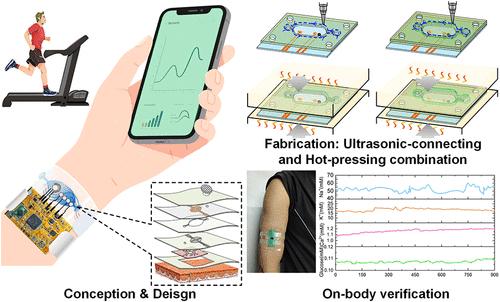用于汗液生物标志物分析的超声连接热压结合多层结构全集成可穿戴微流控电化学传感器
IF 6.7
1区 化学
Q1 CHEMISTRY, ANALYTICAL
引用次数: 0
摘要
可穿戴微流控汗液传感器是连续监测人体生物标志物的关键设备。本研究开发了一种完全集成的可穿戴微流体电化学传感器(FIWMES),用于无创、连续监测人体汗液中的葡萄糖、Na+、K+和Ca2+。为了解决包括样品泄漏、结构损坏和多种生物标志物检测困难在内的挑战,提出了一种结合超声波连接和热压过程的混合键合工艺,用于FIWMES的结构集成。该粘接工艺保证了高的界面粘接强度(65n),优异的密封性能(200弯后无泄漏),以及精确的微流控室内温度控制(51°C)。通过集成树突汗液收集模块、微流控室和3d排列的传感单元,FIWMES可以实现高效的汗液捕获、样品处理和同时进行生物标志物检测。葡萄糖传感器的灵敏度为6.4 μA/mM,具有较强的抗干扰能力,而Na+、K+和Ca2+传感器的灵敏度分别为65.3、64.3和38.2 mV/decade,显示出接近nernstian的响应。在身体上的试验证实了它的实用性和准确跟踪动态代谢变化的能力,如餐后汗液葡萄糖的增加和缺水情况下电解质的变化。FIWMES具有稳定性和监测能力,为有效管理慢性病提供了技术平台。本文章由计算机程序翻译,如有差异,请以英文原文为准。

A Fully Integrated Wearable Microfluidic Electrochemical Sensor with Ultrasonic Connecting and Hot-Pressing Bonded Multilayer Structure for Sweat Biomarker Analysis
Wearable microfluidic sweat sensors serve as critical devices for the continuous monitoring of human biomarkers. This research has developed a fully integrated wearable microfluidic electrochemical sensor (FIWMES) for noninvasive, continuous monitoring of glucose, Na+, K+, and Ca2+ in human sweat. To address challenges including sample leakage, structure damage, and difficulties of multiple-biomarker detection, a hybrid bonding process that combines ultrasonic connecting and hot-pressing procedures is presented for structural integration of the FIWMES. The bonding process ensures high interfacial bonding strength (>65 N), excellent sealing performance (no leakage after 200 bends), and precise temperature control (<51 °C) inside the microfluidic chamber. By integrating the dendritic sweat-collecting module, microfluidic chamber, and 3D-arranged sensing units, the FIWMES can achieve efficient sweat capture, sample manipulation, and simultaneous biomarker detection. The glucose sensor exhibits a sensitivity of 6.4 μA/mM with strong anti-interference capability, while the Na+, K+, and Ca2+ sensors display near-Nernstian responses with sensitivities of 65.3, 64.3, and 38.2 mV/decade, respectively. On-body trials confirm the practical wearability and its ability to accurately track dynamic metabolic changes, such as postprandial increases in sweat glucose and electrolyte variation under water deficiency. With its stability and monitoring capabilities, FIWMES offers a technical platform for the effective management of chronic diseases.
求助全文
通过发布文献求助,成功后即可免费获取论文全文。
去求助
来源期刊

Analytical Chemistry
化学-分析化学
CiteScore
12.10
自引率
12.20%
发文量
1949
审稿时长
1.4 months
期刊介绍:
Analytical Chemistry, a peer-reviewed research journal, focuses on disseminating new and original knowledge across all branches of analytical chemistry. Fundamental articles may explore general principles of chemical measurement science and need not directly address existing or potential analytical methodology. They can be entirely theoretical or report experimental results. Contributions may cover various phases of analytical operations, including sampling, bioanalysis, electrochemistry, mass spectrometry, microscale and nanoscale systems, environmental analysis, separations, spectroscopy, chemical reactions and selectivity, instrumentation, imaging, surface analysis, and data processing. Papers discussing known analytical methods should present a significant, original application of the method, a notable improvement, or results on an important analyte.
 求助内容:
求助内容: 应助结果提醒方式:
应助结果提醒方式:


